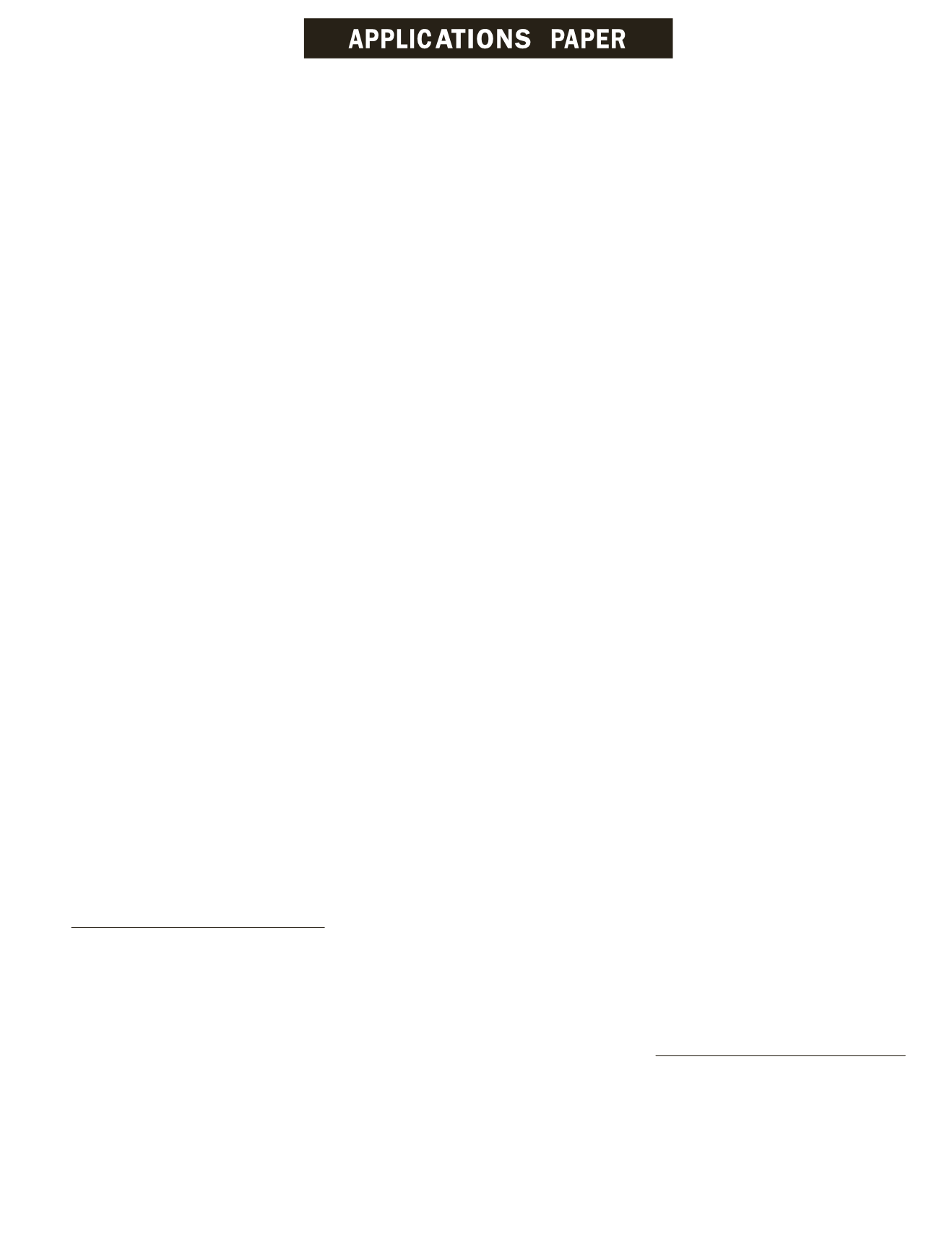
A Fully Automatic Method to Extract
Rare Earth Mining Areas from Landsat Images
Bo Wu, Chaoyang Fang, Le Yu, Xin Huang, and Qiang Zhang
Abstract
This paper proposes a new morphological mining feature
index (
MMFI
) by synthesizing multi-scale and multi-direc-
tion differential morphological profiles (DMPs) to effectively
separate
REMA
s from other land covers with similar spectral
signals and local brightness contrast. The
MMFI
enhances the
local brightness contrast of rare earth mining areas (
REMA
s)
by highlighting the morphological characteristics of
REMA
structure, and improves the identification of roads and bare
soil, which have similar spectral signatures to
REMA
s. More-
over, a new threshold optimization method that maximizes
the histogram entropy is presented, whereby
REMA
s can be
automatically extracted from the
MMFI
image without sample
collection and machine learning. Therefore, it is a fully auto-
matic method suitable for
REMA
extraction over large areas. To
validate the proposed method, three temporal Landsat images
acquired of Changting County, China, were used to extract
REMA
information. Our results demonstrate that the proposed
method can achieve good classification accuracy compared
with other methods.
Introduction
China, known as the “kingdom of rare earths,” is among the
world’s leading countries in terms of rare earth resources,
producing over 90 percent of the world’s supply in recent
years (China National Bureau of Statistics, 2010). A large and
rapid increase in the extraction and use of rare earth elements
(
REE
) has occurred in recent years; however, the use of simple
mining techniques and inadequate supervision of local gov-
ernment has caused substantial increases in the contamina-
tion levels of soil and water around the mining areas (Olias
et
al
., 2005; Miao
et al
., 2011; Li
et al
., 2013). Therefore, mon-
itoring rare earth mining areas (
REMA
s) and their dynamics
in a timely and cost-effective manner is highly desirable for
environmental agencies and policy makers, as it can provide a
scientific base for integrated pollution control and ecological
remediation of contaminated environment.
Satellite-based Earth observations record synoptic and
repetitive data over very large areas. The acquired images,
particularly those of the Landsat Thematic Mapper/Enhanced
Thematic Mapper plus (
TM/ETM+
) and Advanced Spaceborne
Thermal Emission and Reflection Radiometer (
ASTER
) are a
valuable data source for mapping assemblages of alteration
minerals (Crosta and Moore, 1989; Rowan and Mars, 2003;
Mars
et al.
, 2011; Pour and Hashim, 2012), such as iron ox-
ides, clay, and alunite, that occur in hydrothermally altered
rocks, especially in inaccessible areas (Rowan and Mars,
2003; Chen
et al
., 2007). Each land-cover type has a diagnos-
tic spectral response that can be generally identified from sat-
ellite images; this constitutes the theoretical basis of land-cov-
er mapping and classification. The spectrum of the reflected
energy can be determined from the image brightness; using
spectral analysis we can then identify objects in the image.
In practice, however, the brightness is influenced by several
factors including atmospheric effects, the spectral and spatial
resolution of the image, sub-pixel level heterogeneity in the
chemical and mineralogical composition of the rock, and the
presence of soil, vegetation cover, and surface weathering (Yu
et al
., 2011). Therefore, for efficient lithological or mining
classification, texture information is usually extracted from
remote sensing data, adding additional features to the dataset
(e.g., Li
et al
., 2009; Yu
et al
., 2012). The textual features are
essential information for image classification, because they
provide important clues for identifying homogeneous land
cover in complex regions.
To extract
REMA
s, image features such as the spectrum,
shape, and texture of the land cover are required. Plate 1
shows examples of typical land covers in the study area.
Mining activities create features that can be observed in re-
motely sensed images, which provide distinctive information
for detecting the
REMA
. Basically, there are three commonly
used methods for distilling iron-based rare earth ore in south
China, i.e., the
in-situ
leaching method, pond leaching meth-
od, and
in-situ
heap leaching method, all of which inevitably
cause vegetation deterioration. For example, the image of the
site where
in-situ
leaching was used (Plate 1) shows a pattern
of stripes (high-density points) along the mountain ridge.
In contrast, the images of the
in-situ
leaching site and pond
leaching site show large areas of vegetation deterioration.
Because
REMA
s in southern China are found mostly in rug-
ged mountain areas, the spectra of the land covers are strongly
affected by the terrain; therefore, spectral-based classification
of land cover is unreliable. Accordingly, in this study we
focused our analysis on determining effective image textural
features for
REMA
target identification. Some commonly used
spatial texture features include wavelet texture (Ouma
et al
.,
2006), the gray-level co-occurrence matrix (
GLCM
) (Myint
et al
.,
2004), morphological profiles (Pesaresi and Benedifsson, 2001;
Fauvel
et al
., 2008), and fractal texture (Li
et al
., 2014); some
of these are used for
REMA
mapping (Peng
et al
., 2013; Li
et al
.,
2014). However, many of these algorithms refer to the super-
vised approaches, where a large number of training samples
Bo Wu and Qiang Zhang are with the Key Lab of Spatial Data
Mining and Information Sharing of Ministry of Ed-
ucation, Fuzhou University, 523 Gongye Road, Fuzhou, P. R.
China (
).
Bo Wu and Chaoyang Fang are with the Key Laboratory of
Poyang Lake Wetland and Watershed Research, Ministry of
Education, Jiangxi Normal University, Nanchang, China.
Le Yu is with the Ministry of Education Key Laboratory for
Earth System Modeling, Center for Earth System Science,
Tsinghua University, Beijing, 100084, China.
Xin Huang is with the School of Remote Sensing and Infor-
mation Engineering, Wuhan University 129, Luoyu Road,
Wuhan, 430079, China.
Photogrammetric Engineering & Remote Sensing
Vol. 82, No. 9, September 2016, pp. 729–737.
0099-1112/16/729–737
© 2016 American Society for Photogrammetry
and Remote Sensing
doi: 10.14358/PERS.82.9.729
PHOTOGRAMMETRIC ENGINEERING & REMOTE SENSING
September 2016
729


